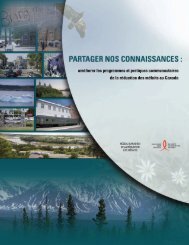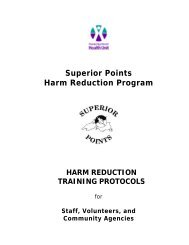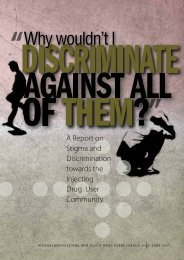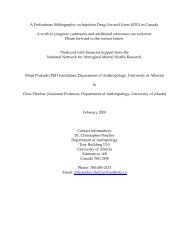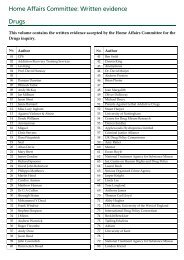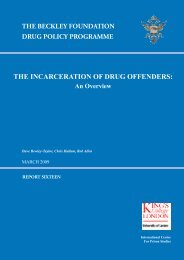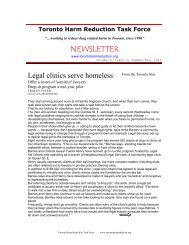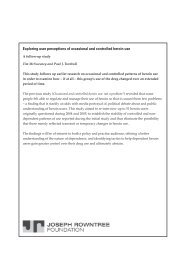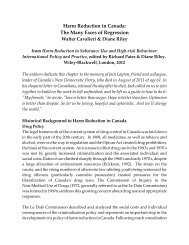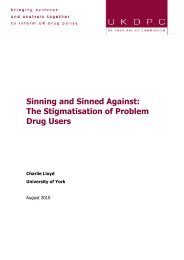Yes in my backyard! - Pivot Legal Society
Yes in my backyard! - Pivot Legal Society
Yes in my backyard! - Pivot Legal Society
Create successful ePaper yourself
Turn your PDF publications into a flip-book with our unique Google optimized e-Paper software.
AGM<strong>Yes</strong>, In <strong>my</strong> Backyard:Welcom<strong>in</strong>g <strong>in</strong>clusion, uphold<strong>in</strong>g human rights
CONTENTSABOUT THIS TOOLKIT ....................................................................................................................5THE RIGHT TO HOUSING ................................................................................................................6A CASE STUDY – COQUITLAM .......................................................................................................6WHAT DO WE MEAN BY SUPPORTIVE HOUSING? ......................................................................8TRANSFORMING NIMBYISM TO YIMBYISM ..................................................................................8QUICK STATS PROVIDED BY THE CITY OF VANCOUVER ...............................................................9HUMAN RIGHTS IN BRITISH COLUMBIA .......................................................................................10A CASE STUDY – UBC HOSPICE ....................................................................................................12TAKE THE CRINGE TEST ................................................................................................................12“HOW TO” GUIDE FOR NEW YIMBYS .............................................................................................14A CASE STUDY – UNION GOSPEL MISSION AND GOOD NEIGHBOUR AGREEMENTS ...............17A CASE STUDY – RAINCITY HOUSING’S FRASER STREET DEVELOPMENT ................................17...WHEN YOU FIRST HEAR ABOUT A HOUSING PROPOSAL .........................................................18HELPFUL DOCUMENTS ................................................................................................................19LEGAL PERSPECTIVE ....................................................................................................................20THE B.C. HUMAN RIGHTS CODE ...................................................................................................20THE CANADIAN CHARTER OF RIGHTS AND FREEDOMS .............................................................22CIVIL AND CRIMINAL LAW ............................................................................................................24WHAT CAN YOU DO – HOW TO APPLY THE LAW ..........................................................................25TIPS FOR YIMBYS WHO WANT TO SUPPORT A HOUSING PROJECT ............................................26“HOW TO” GUIDE FOR YIMBY SERVICE PROVIDERS ....................................................................30VANCOUVER CITY COUNCIL - BASIC PLANNING APPROVAL PROCESS .....................................30BASIC FLOW CHART OF APPROVAL PROCESS .............................................................................33TOP TIPS FOR HOUSING PROVIDERS ............................................................................................34A CASE STUDY – RAINCITY HOUSING AND THE FRASER & 41ST STREET SITE ........................34A CASE STUDY - SALSBURY COMMUNITY PROJECT ...................................................................38RESOURCES AT YOUR FINGERTIPS ..............................................................................................40
This kit offers simple tips for build<strong>in</strong>g a more <strong>in</strong>clusive Vancouver.ABOUT THIS TOOLKITThis kit is <strong>in</strong>tended for YIMBYs: people who understand the value of address<strong>in</strong>g homelessness,addictions, and mental illness <strong>in</strong> a proactive and positive way through safe and supportive hous<strong>in</strong>g,and who want to say “<strong>Yes</strong> <strong>in</strong> <strong>my</strong> <strong>backyard</strong>!” to projects that help people get off the streets. We hopeyou will f<strong>in</strong>d this guide useful <strong>in</strong> help<strong>in</strong>g you respond to fears and prejudices about the people wholive <strong>in</strong> supportive hous<strong>in</strong>g.THIS KIT! Expla<strong>in</strong>s the “right to hous<strong>in</strong>g”! Provides a framework for go<strong>in</strong>g from NIMBY (Not <strong>in</strong> <strong>my</strong> <strong>backyard</strong>) to YIMBY (<strong>Yes</strong> <strong>in</strong> <strong>my</strong> <strong>backyard</strong>)! Offers useful <strong>my</strong>th bust<strong>in</strong>g <strong>in</strong>formation! Details B.C.’s Human Rights Code and the legal framework to support the YIMBY position! Includes case studies of challenges and success storiesDeveloped through the collaboration of shelter providers and advocacy groups, this kit offerssimple tips for build<strong>in</strong>g a more <strong>in</strong>clusive Vancouver.DEDICATIONThis toolkit is dedicated to all the <strong>in</strong>credible people across Vancouver work<strong>in</strong>g and volunteer<strong>in</strong>g tofight homelessness. Your commitment to mak<strong>in</strong>g Vancouver a better community for everyone is atribute to humanity’s compassion for one another.
THE RIGHT TO HOUSINGTh<strong>in</strong>k about where you live today – an apartment, a townhouse, a house – how important is this place?What value do you put on hav<strong>in</strong>g shelter where you sleep, a place to keep you secure and safe? Regardlessof whether you rent or own, how hard would life be without a place to call your own? This situation is thereality for grow<strong>in</strong>g numbers of Vancouver residents.Now imag<strong>in</strong>e that you have to move and your new neighbours – neighbours who say they have noth<strong>in</strong>gpersonal aga<strong>in</strong>st you – say damag<strong>in</strong>g and untrue th<strong>in</strong>gs about you through email, flyers, posters, <strong>in</strong>ternetblogs, and at public meet<strong>in</strong>gs. If you live <strong>in</strong> British Columbia, you would probably say that your rights hadbeen violated. Yet <strong>in</strong> this prov<strong>in</strong>ce, many people experience exactly this whenever a much needed service,like shelter or hous<strong>in</strong>g, is proposed.At <strong>Pivot</strong> <strong>Legal</strong> <strong>Society</strong>, we believe that everyone has a basic right to hous<strong>in</strong>g. That means communityadvocates, hous<strong>in</strong>g developers, elected officials, and compassionate neighbours must speak out whenhuman rights are violated by NIMBYism. Otherwise, communities are emboldened to believe they canzone out people they see as “undesirable.”The need for supportive hous<strong>in</strong>g <strong>in</strong> Vancouver and throughout the prov<strong>in</strong>ce – by which we mean safeaffordable hous<strong>in</strong>g with support services for people with mental health and/or addiction issues – isundeniable. A lack of decent hous<strong>in</strong>g is one of the most significant barriers to full participation <strong>in</strong> communitylife. Without good quality hous<strong>in</strong>g, many people cycle between jails, hospitals, shelters and the streets,cost<strong>in</strong>g governments far more than the price of actually provid<strong>in</strong>g supportive hous<strong>in</strong>g! 1A CASE STUDY – COQUITLAMIn early 2010 Coquitlam city council held public hear<strong>in</strong>gs on a proposal to build a homeless shelter on lands identifiedfor this purpose <strong>in</strong> 2008. Community resistance to this shelter was such that RCMP officers had to be called to monitorthese meet<strong>in</strong>gs 2 . The concerns raised by community residents <strong>in</strong>cluded <strong>in</strong>creased crime, noise, and lowered propertyvalues.“Homelessness advocates and service providers spoke <strong>in</strong> favour of the planned facility, as did former homeless people,high school students and area residents. In the end, Coun. Lou Sekora was the lone councilor to vote aga<strong>in</strong>st theproposal, which began discussion at 7pm with a public hear<strong>in</strong>g portion and ended just shy of 1am with the f<strong>in</strong>al vote.About 300 people were <strong>in</strong> attendance.”Read more: http://www.thenownews.com/news/Coquitlam+homeless+shelter/3911358/story.html#ixzz1HwaAr3aT
22%<strong>in</strong>crease <strong>in</strong> metro vancouvers homelessWHAT DO WE MEAN BYSUPPORTIVE HOUSING?Supportive hous<strong>in</strong>g can mean short termshelter for the homeless due to <strong>in</strong>clementweather, it can be transitional whilesomeone is work<strong>in</strong>g towards a morestable situation, and it can bepermanent for those with physical ormental disabilities that require someongo<strong>in</strong>g assistance.While a lack of fund<strong>in</strong>g is one of thebiggest obstacles to safe and affordablehous<strong>in</strong>g, another significant barrier, andone we hope to address <strong>in</strong> this kit, iscommunity opposition or NIMBYism,when people say “Not <strong>in</strong> <strong>my</strong> <strong>backyard</strong>!”There is significant research andevidence to show that concerns such ascrime, noise, and lowered propertyvalues are unfounded. The key tocounter<strong>in</strong>g these obstacles is to provideawareness and understand<strong>in</strong>g tocommunities early <strong>in</strong> the process.TRANSFORMING NIMBYISMTO YIMBYISMThe term NIMBYism has been around along time and it means to take adefensive position aga<strong>in</strong>st a plannedproject <strong>in</strong> your community.It can be applied to a broad range ofprojects from community gardens andneedle boxes to group homes for thedisabled and shelters for the homeless.Typically an announcement is made thata project is be<strong>in</strong>g proposed <strong>in</strong> theneighbourhood and the community rallies<strong>in</strong> protest to prevent its development.Often the concerns raised by neighboursare based on assumptions the proposedproject will <strong>in</strong>crease crime, noise, theftand lower property values. While theseare very real concerns, they are notaligned with the evidence.See our section on <strong>my</strong>th bust<strong>in</strong>g for somesuggestions on how to respond to theseconcerns.WHY YIMBY?Liv<strong>in</strong>g <strong>in</strong> Vancouver means we share thiscity with diverse peoples from all overthe world. Shar<strong>in</strong>g this space also meansensur<strong>in</strong>g that everyone, regardless off<strong>in</strong>ancial situation or physical/mentalability is also welcome <strong>in</strong> anyneighbourhood.It’s been almost two decades s<strong>in</strong>ce thefederal government handed offresponsibility for hous<strong>in</strong>g to theprov<strong>in</strong>ces, mak<strong>in</strong>g Canada the onlyG-8 country without a national hous<strong>in</strong>gstrategy.The end result is a hous<strong>in</strong>g crisis that theUN described as a “national emergency.”Say<strong>in</strong>g “<strong>Yes</strong>, <strong>in</strong> <strong>my</strong> <strong>backyard</strong>” meanssay<strong>in</strong>g yes to accept<strong>in</strong>g our community’scollective responsibility to make ourshared space welcom<strong>in</strong>g to everyone.
QUICK STATS PROVIDED BY THECITY OF VANCOUVER:! The March 2008 homeless count found1,576 homeless people <strong>in</strong> Vancouver,account<strong>in</strong>g for 60% of the regional total.Of those counted 765 stayed <strong>in</strong>emergency shelters and 811 wereshelterless 3 .! The March 2008 regional homelesscount showed a 22% <strong>in</strong>crease <strong>in</strong> peoplewho are homeless <strong>in</strong> the MetroVancouver region – from roughly 2,200homeless <strong>in</strong> 2005 to 2,600 <strong>in</strong> 2008.S<strong>in</strong>ce 2002, the year of the firstregional homeless count,homelessness has <strong>in</strong>creased 140%across the region 4 .! The number of shelter beds <strong>in</strong> MetroVancouver <strong>in</strong> w<strong>in</strong>ter months has<strong>in</strong>creased from 550 beds <strong>in</strong> 2000 to1,480 beds <strong>in</strong> 2008. 1,193 of thosebeds, or three-quarters of the regionaltotal, are located <strong>in</strong> Vancouver 5 .Despite an <strong>in</strong>creas<strong>in</strong>g number ofshelter beds, homelessness is onthe rise. We need to ma<strong>in</strong>ta<strong>in</strong> exist<strong>in</strong>gshelters and open new sites todevelop long term solutions.
REASONS TO BE HOPEFULSixty years ago <strong>in</strong> Canada, there were subdivisions that prevented Jewish, Asian and African-Canadians frompurchas<strong>in</strong>g a home. The people who set up these restrictions believed they were protect<strong>in</strong>g property values,public safety and good neighbourhoods.Now, such a practice would be unth<strong>in</strong>kable. Why? Because courts ruled such practices illegal. And becausethe overwhelm<strong>in</strong>g evidence has shown that neighbourhoods had noth<strong>in</strong>g to fear, and everyth<strong>in</strong>g to ga<strong>in</strong>,from welcom<strong>in</strong>g residents of all ethnicities and religions. There have been rul<strong>in</strong>gs recently aga<strong>in</strong>st similarmunicipal policies which attempt to “zone people” rather than land use. There have also been studies donethat show the positive impact that social hous<strong>in</strong>g projects have on neighbourhoods.Over the past 20 years, supportive hous<strong>in</strong>g has proven its contribution to healthy neighbourhoods.In Vancouver, visionary organizations and <strong>in</strong>dividuals are help<strong>in</strong>g to change the way we th<strong>in</strong>k about theright to hous<strong>in</strong>g and provid<strong>in</strong>g practical solutions to help end homelessness.There’s more good news. On March 7, 2011, the Vancouver Sun shared results from a survey confirm<strong>in</strong>gBritish Columbians are particularly supportive of anti-poverty <strong>in</strong>itiatives. This means that Vancouver, morethan many other Canadian cities, is ready to tackle poverty and elim<strong>in</strong>ate homelessness. We look forwardto the day, and believe it will come soon, when discrim<strong>in</strong>ation aga<strong>in</strong>st homeless people, people with mentalhealth issues or other disabilities is unth<strong>in</strong>kable.Check it out - www.streetohome.orgHUMAN RIGHTS IN BRITISH COLUMBIAIf neighbours hurl public <strong>in</strong>sults at the people who hope to live on their street, are they simply exercis<strong>in</strong>gtheir right to free speech?Do local residents’ associations have the right to screen who moves <strong>in</strong>to the neighbourhood?Do municipalities have the right to prevent certa<strong>in</strong> types of people from mov<strong>in</strong>g <strong>in</strong>to a neighbourhood, on thegrounds that the area already has “more than its fair share” of these types of people?If you imag<strong>in</strong>e the people <strong>in</strong> question are racial, ethnic or religious m<strong>in</strong>orities, the answer is obviously no. Werecognize that many Canadians have prejudices and fears about people who are different from themselves.But we do not allow these prejudices to compromise basic human rights.
In British Columbia, anyone mak<strong>in</strong>g a racial slur at apublic meet<strong>in</strong>g would be ruled out of order. A residents’association that organized to keep Jewish people out ofthe neighbourhood would be denounced. No municipalitywould set up rules to prevent “an over-concentration ofItalians,” or to ensure no Catholic family lived with<strong>in</strong> 400metres of other Catholics.
However, many British Columbians believe that it is acceptable to discrim<strong>in</strong>ate aga<strong>in</strong>st people who arementally ill, disabled, or poor. They are mistaken.People who have a mental illness, another disability or who are on social assistance have the same rightswe all enjoy.No one should have to ask permission from their neighbours before mov<strong>in</strong>g <strong>in</strong> next door.Nobody goes knock<strong>in</strong>g on doors before buy<strong>in</strong>g or rent<strong>in</strong>g a home to ask whether it’s okay that they move <strong>in</strong>.Everyone has a right to live where they want, without apology and without hav<strong>in</strong>g to justify their choice. Thecommunity’s permission is not a necessary prerequisite. While there may be plann<strong>in</strong>g approvals that mustbe obta<strong>in</strong>ed before a new build<strong>in</strong>g can be built, municipal plann<strong>in</strong>g by-laws regulate land use and build<strong>in</strong>gform, not the people who will live there.Check it out - http://www.ag.gov.bc.ca/human-rights-protection/A CASE STUDY – UBC HOSPICEIn January 2010 a proposal to build a 15-bed hospice next door to an 18-storey condom<strong>in</strong>ium build<strong>in</strong>g on UBC groundsraised significant resistance from condo owners. Residents’ argued that liv<strong>in</strong>g next to a hospice went aga<strong>in</strong>st Ch<strong>in</strong>esebeliefs, and decreased property values. While build<strong>in</strong>g is currently on hold, many people have contradicted the culturalconcerns raised by condo residents as an <strong>in</strong>accurate representation of Ch<strong>in</strong>ese culture.Read more: http://www.globaltvbc.com/money/Angry+condo+owners+protest+hospice/4103582/story.htmlTAKE THE CRINGE TESTThe Cr<strong>in</strong>ge Test is a tool you can use to tell the difference between discrim<strong>in</strong>ation and a legitimateobjection to supportive hous<strong>in</strong>g. If it sounds wrong when you say the same th<strong>in</strong>g about a racial, ethnicor religious m<strong>in</strong>ority, then you know you’ve heard a discrim<strong>in</strong>atory statement and this statement goesaga<strong>in</strong>st the B.C. Human Rights Code.
WOULD YOU SAY...?This neighbourhood already has its fair share of peopleon welfare.The homeless should be placed only on arterial roads.This neighbourhood is just not suitable forvulnerable mentally ill people.Welfare recipients lower property values anddra<strong>in</strong> public services.Houses for people with disabilities must beseparated by 245 metres.We are plac<strong>in</strong>g a moratorium on hous<strong>in</strong>g forlow-<strong>in</strong>come people while we study the impacton the area.We deserve to be warned before people with mentalillness move onto our street.We are a tolerant people. We have been happy towelcome people with mental illness <strong>in</strong>to ourneighbourhood. But enough is enough.We don’t want mentally ill people, but we’re will<strong>in</strong>g toaccept seniors.If mentally ill people are go<strong>in</strong>g to live here, then I wantthe build<strong>in</strong>g to have:A 12-foot high wall around it !Bars on the w<strong>in</strong>dows !Frosted w<strong>in</strong>dows so they can’t look out !W<strong>in</strong>dows that can’t open !A curfew !...IF IT MAKES YOU CRINGE TO SAY?This neighbourhood already has its fair shareof Italians.Jews should be placed only on arterial roads.This neighbourhood is just not suitable forvulnerable Asian people.Senior citizens lower property values and dra<strong>in</strong>public services.Houses for Catholics must be separated by245 metres.We are plac<strong>in</strong>g a moratorium on hous<strong>in</strong>g forGreeks while we study the impact on the area.We deserve to be warned before gays and lesbiansmove onto our street.We are a tolerant people. We have been happyto welcome the Ch<strong>in</strong>ese <strong>in</strong>to our neighbourhood.But enough is enough.We don’t want Muslims, but we’re will<strong>in</strong>g to acceptProtestants.If black people are go<strong>in</strong>g to live here, then I want thebuild<strong>in</strong>g to have:! A 12-foot wall around it! Bars on the w<strong>in</strong>dows! Frosted w<strong>in</strong>dows so they can’t look out! W<strong>in</strong>dows that can’t open! A curfew.
“HOW TO” GUIDE FOR NEW YIMBYSYou’ve decided to become a YIMBY and jo<strong>in</strong> the fight aga<strong>in</strong>st homelessness, but you’re not sure where tostart. It’s important you are <strong>in</strong>formed about how you can support proposed developments <strong>in</strong> yourcommunity, and how the law can help.MYTH BUSTINGA Homeless Shelter will decrease the value of <strong>my</strong> home.Home ownership is perhaps the most significant <strong>in</strong>vestment made by any <strong>in</strong>dividual or family. Allhomeowners want to feel that their <strong>in</strong>vestment is secure and that, if and when they decide to sell theirhome, its value won’t be negatively affected by their neighbours’ properties. Fortunately, social andsupportive hous<strong>in</strong>g does not have a negative impact on property values. Consider two important studies,one local and one <strong>in</strong>ternational:1 The British Columbia M<strong>in</strong>istry of Hous<strong>in</strong>g, Recreation and Consumer Services conducted a study <strong>in</strong>1995 <strong>in</strong> seven different regions of the prov<strong>in</strong>ce. In each region they compared the market fluctuations<strong>in</strong> an area with supportive hous<strong>in</strong>g to another area with none. In all seven cases, the appraisers found:! No evidence that the presence of the supportive hous<strong>in</strong>g negatively affected the sale prices ofhomes <strong>in</strong> the impact area. House prices <strong>in</strong> the vic<strong>in</strong>ity of the non-market project <strong>in</strong>creased asmuch – and <strong>in</strong> some cases, more – than nearby areas of similar hous<strong>in</strong>g types and ages;! No evidence of panic sell<strong>in</strong>g or extraord<strong>in</strong>ary length of time on the market between the dates oflist<strong>in</strong>g and sale 6 .2 New York University’s Furman Center for Real Estate and Urban Policy released a report <strong>in</strong> 2008evaluat<strong>in</strong>g the impacts of 123 supportive hous<strong>in</strong>g developments across the city’s five boroughs overan 18 year period. Their results showed that:! Properties with<strong>in</strong> 500 feet of the supportive hous<strong>in</strong>g development experienced steady growth<strong>in</strong> value! Properties between 500 feet and 1000 feet of supportive hous<strong>in</strong>g developments alsoexperienced growth <strong>in</strong> value, but at a slightly slower pace! Neither the size of the development nor the density of the neighbourhood had an impact onthe results 7 .
Supportive hous<strong>in</strong>g is a waste of taxpayers’ money.At <strong>Pivot</strong> <strong>Legal</strong> <strong>Society</strong>, we believe that everyone, <strong>in</strong>clud<strong>in</strong>g the most vulnerable members of the community has a right to safe hous<strong>in</strong>g.However, calculations show that a “hous<strong>in</strong>g first” model also makes good economic sense.1 In 2006, BC Hous<strong>in</strong>g asked the Centre for Applied Research <strong>in</strong> Mental Health and Addictions for a report on the economic impactof homelessness <strong>in</strong> British Columbia.The report found that the cost of respond<strong>in</strong>g to homelessness with ambulances, hospitals, police, courts and jails far exceedsthe cost of provid<strong>in</strong>g suitable hous<strong>in</strong>g:! Non-hous<strong>in</strong>g service costs amount to about $644.3 million per year across the prov<strong>in</strong>ce – the average street homeless adultwith SAMI (severe addictions and/or mental illness) <strong>in</strong> BC costs the public system <strong>in</strong> excess of $55,000 per year;! Provision of adequate hous<strong>in</strong>g and supports is estimated to reduce this cost to $37,000 per year;! This results <strong>in</strong> an overall “cost avoidance” of about $211 million per year; and! The “cost avoidance” <strong>in</strong> health care and prov<strong>in</strong>cial corrections <strong>in</strong>stitution costs are more than sufficient to offset the capitalcosts and the costs of provid<strong>in</strong>g hous<strong>in</strong>g supports to those who are absolutely homeless 8 .2 There are also significant costs associated with the measures elected officials and hous<strong>in</strong>g developers must undergo <strong>in</strong> orderto battle discrim<strong>in</strong>atory community activism. That is why it is so important for all of us to speak up <strong>in</strong> support of these importantprojects.3 Some people argue supportive hous<strong>in</strong>g will attract drug dealers and crim<strong>in</strong>als to the neighbourhood and make the communityless safe. We all have a right to be safe <strong>in</strong> our homes and neighbourhoods. Experience shows that build<strong>in</strong>g social hous<strong>in</strong>g helpsimprove safety and security <strong>in</strong> communities and leads to reductions <strong>in</strong> crime. Consider the follow<strong>in</strong>g:"" ! When two homeless shelters opened last year <strong>in</strong> the West End of Vancouver, the City of Vancouver reported that the numberof people sleep<strong>in</strong>g outside dropped from 267 to 12, and there was a significant decrease <strong>in</strong> <strong>in</strong>cidences of aggressivepanhandl<strong>in</strong>g. The Vancouver Police Department reported 16% fewer crimes <strong>in</strong> the area compared to the year before."" ! The Vancouver Police have publicly called for <strong>in</strong>vestments <strong>in</strong> affordable hous<strong>in</strong>g and support services for the homeless andpeople with mental illness as a means of reduc<strong>in</strong>g crime and improv<strong>in</strong>g communities. Moreover, supportive hous<strong>in</strong>g helpsfree up police and resources to deal with serious crimes, rather than deal<strong>in</strong>g with by-law <strong>in</strong>fractions related to homelessness."" ! Most residents liv<strong>in</strong>g near social hous<strong>in</strong>g build<strong>in</strong>gs do not even know that the facilities exist. After a facility is runn<strong>in</strong>g, manyof those who were <strong>in</strong>itially opposed to the project come to support it, or simply forget about it.
"! Residents of social hous<strong>in</strong>g facilities contribute to mak<strong>in</strong>g their neighbourhoods vibrant, safe,<strong>in</strong>clusive and welcom<strong>in</strong>g places to live!For additional <strong>my</strong>ths and facts about homelessness, please visit:http://communitychallenge.files.wordpress.com/2008/06/<strong>in</strong>fo_sheet_<strong>my</strong>ths_about_homelessness_081.pdfA CASE STUDY – UNION GOSPEL MISSION AND GOOD NEIGHBOUR AGREEMENTSThe Union Gospel Mission (UGM) is one of Vancouver’s largest supportive hous<strong>in</strong>g providers with multiplesites across Metro Vancouver. In January 2010, UGM created a Good Neighbour Agreement (GNA) toassist with relations between their supportive hous<strong>in</strong>g site and Vancouver’s Strathcona and DowntownEastside communities.Simply put, a GNA outl<strong>in</strong>es an organizations, commitment to be<strong>in</strong>g a good neighbour. It’s a way to promotedialogue and earn trust <strong>in</strong> the community. For UGM, the agreement helped dispel contentious disputes,and while not a legally b<strong>in</strong>d<strong>in</strong>g document, the GNA addressed local residents’ concerns as it was craftedwith their participation.A CASE STUDY – RAINCITY HOUSING’S FRASER STREET DEVELOPMENTWhen Ra<strong>in</strong>City Hous<strong>in</strong>g and Support <strong>Society</strong>’s supportive hous<strong>in</strong>g development at 5616 Fraser Street <strong>in</strong>Vancouver officially opened <strong>in</strong> October 2007, there was cause for celebration. Not only does the build<strong>in</strong>gprovide much-needed hous<strong>in</strong>g for 30 clients with concurrent disorders, this NIMBY-plagued project alsoopened its doors to a welcom<strong>in</strong>g community.Dur<strong>in</strong>g the development stage, there was fierce opposition from the neighbours: 3,000 residents opposedthe site, while only 16 residents endorsed it. Nevertheless, Vancouver City Council decided to proceed.A Community Advisory Committee was established to liaise with surround<strong>in</strong>g residents and bus<strong>in</strong>essesthrough the entire process.When residents began mov<strong>in</strong>g <strong>in</strong>to the three-story concrete build<strong>in</strong>g, apprehension was <strong>in</strong>evitable. The surround<strong>in</strong>gcommunity, however, seemed unaware. People pass<strong>in</strong>g by actually stopped to ask whether theapartments were rental or condo and whether they could fill out an application. Bus<strong>in</strong>esses <strong>in</strong> the communityalso made the new residents feel welcome.Read more: http://www.bchous<strong>in</strong>g.org/break<strong>in</strong>gthecycle/stories_of_hope/development_profiles/fraserstreet
2,600metro vancouver’s homeless <strong>in</strong> 2008HOW TO SUPPORT A NEW PROJECT...WHEN YOU FIRST HEAR ABOUT A PROPOSAL! Contact the developer or the non-profit organization who will be manag<strong>in</strong>g theproject. Tell them you are a supporter. Ask how you can help.! Consider “who you are” <strong>in</strong> relation to the proposal, and why you support it.! Contact people who might also support the proposal. Keep them <strong>in</strong>formed, or l<strong>in</strong>kthem directly to your <strong>in</strong>formation source.The goal: to create a nimble network of supporters and to plan the “message”that will <strong>in</strong>form your actionsWRITTEN COMMUNICATIONEmail, phone or write a letter to your councillor.! Write a letter to city council.! Let them know you support the development.! Caution them aga<strong>in</strong>st a “double standard” – requir<strong>in</strong>g public consultations justbecause the people who will move <strong>in</strong> are disabled or on social assistance.Urge them to uphold the City’s responsibilities under the Charter to treat all itsresidents equally.! Send copies of letters or emails to the organization manag<strong>in</strong>g the project.The goal: To show beleaguered councilors there is strong support for thedevelopment and to ensure all councilors understand the human rightsimplications of their actions.**See the sample letters at the end of the kit for suggestions....AT THE DEVELOPMENTPERMIT BOARD MEETINGThe Board meets once every two weeksand their meet<strong>in</strong>gs are always open to thepublic.F<strong>in</strong>d out more details on the City ofVancouver Development Services website:vancouver.ca/commsvcs/developmentservices/! Go to the meet<strong>in</strong>g and speak out.You do not need to register <strong>in</strong> advance.Be brief. Plan what you will say withthe hous<strong>in</strong>g developer and otherspeakers to avoid duplication! Be ready to wait – the Committee maybe hear<strong>in</strong>g many cases on the sameday, and cannot always tell you whenyour item will come up on its agenda.The goal: To demonstrate neighbourhoodsupport for the proposal to both theCommittee and City Council....IF THERE IS AN OPEN HOUSE! Encourage as many supporters as possible to attend! Write a letter to the plann<strong>in</strong>g department before or after the meet<strong>in</strong>g (contact <strong>in</strong>formation is usually on the notice), and send acopy to City Council and hous<strong>in</strong>g developers! Speak up at the open house, as early as possible. Speak s<strong>in</strong>cerely and personally.The goal: To give the city planner material for a positive report; to give City Council courage to support the proposal; showopponents they do not speak for the entire community; discourage anyone from mak<strong>in</strong>g discrim<strong>in</strong>atory or offensive remarks.
HELPFUL DOCUMENTS:The City of Vancouver is well-aware of the need for social and supportivehous<strong>in</strong>g. To bolster your submissions, you might want to rem<strong>in</strong>d them ofprevious commitments they have made towards social hous<strong>in</strong>g and supportservices <strong>in</strong> the community:The Hous<strong>in</strong>g Plan for the Downtown Eastside*Recommends <strong>in</strong>creased <strong>in</strong>vestment <strong>in</strong> social hous<strong>in</strong>g <strong>in</strong> the neighbourhood toensure it rema<strong>in</strong>s a place where low-<strong>in</strong>come tenants can cont<strong>in</strong>ue to live. It alsorecommends that the community should be <strong>in</strong>volved <strong>in</strong> monitor<strong>in</strong>g the rate ofchange <strong>in</strong> the neighbourhood to ensure that development of condom<strong>in</strong>iumsdoes not outpace development of affordable hous<strong>in</strong>g.http://vancouver.ca/commsvcs/hous<strong>in</strong>g/pdf/dteshous<strong>in</strong>gplan.pdfThe City’s Homeless Action Plan*Discusses ways the City and the Prov<strong>in</strong>cial Government can reducehomelessness by mak<strong>in</strong>g it easier for people to access welfare, develop<strong>in</strong>gsupportive hous<strong>in</strong>g, and <strong>in</strong>creas<strong>in</strong>g mental health and addiction services.http://vancouver.ca/commsvcs/hous<strong>in</strong>g/pdf/hap05jun.pdfThe Supportive Hous<strong>in</strong>g Strategy*Focuses on hous<strong>in</strong>g for people with mental illnesses or addictions, <strong>in</strong>clud<strong>in</strong>glow barrier hous<strong>in</strong>g for people who may not be actively engaged <strong>in</strong> treatment,and recommends an <strong>in</strong>crease <strong>in</strong> the supply of supportive hous<strong>in</strong>g units <strong>in</strong>newly developed build<strong>in</strong>gs.http://vancouver.ca/commsvcs/hous<strong>in</strong>g/supportivehous<strong>in</strong>gstrategy/pdf/F<strong>in</strong>alSupportiveHous<strong>in</strong>gStrategy.pdf
LEGAL PERSPECTIVEThe right to live <strong>in</strong> a neighbourhood of one’s choice:When someone says, “I don’t want black people (or Jewish people, or gay people, or Ch<strong>in</strong>ese people, or seniors) to live near me,”we know we are hear<strong>in</strong>g a discrim<strong>in</strong>atory statement. We know, because these statements don’t feel right to us.We also know that the B.C. Human Rights Code protects people from discrim<strong>in</strong>ation on the basis of race, religion, sexual orientation,ethnic orig<strong>in</strong> and age.At times it feels like people are more comfortable express<strong>in</strong>g or hear<strong>in</strong>g harsh attitudes about those who have a physical or mentaldisabilities or are poor than they would be about other groups. However, people on <strong>in</strong>come assistance who are look<strong>in</strong>g to rent a houseor apartment are also protected by law. So are people with other disabilities, youth, and newcomers. This section looks at the laws thatprotect these rights, the practices that may violate them, and what you can do to fight discrim<strong>in</strong>ation and uphold these rights.THE B.C. HUMAN RIGHTS CODEThe B.C. Human Rights Code applies to every person liv<strong>in</strong>g <strong>in</strong> this prov<strong>in</strong>ce.Any person who violates the Code can be challenged before the B.C. HumanRights Tribunal.1. GroundsThe B.C. Human Rights Code prohibits discrim<strong>in</strong>ation <strong>in</strong> accommodation <strong>in</strong>two sections.Section 8 says:8. (1) A person must not, without a bona fide and reasonablejustification,(a) deny to a person or class of persons any accommodation, serviceor facility customarily available to the public, or(b) discrim<strong>in</strong>ate aga<strong>in</strong>st a person or class of persons regard<strong>in</strong>g anyaccommodation, service or facility customarily available to the publicbecause of the race, colour, ancestry, place of orig<strong>in</strong>, religion, marital status,family status, physical or mental disability, sex, sexual orientation or age ofthat person or class of persons.Section 10 says:10. (1) A person must not(a) deny to a person or class of persons the right to occupy, as atenant, space that is represented as be<strong>in</strong>g available for occupancyby a tenant, or(b) discrim<strong>in</strong>ate aga<strong>in</strong>st a person or class ofpersons regard<strong>in</strong>g a term or condition of thetenancy of the space,because of the race, colour, ancestry, place oforig<strong>in</strong>, religion, marital status, family status,physical or mental disability, sex, sexualorientation, age or lawful source of <strong>in</strong>come of thatperson or class of person, or of any other personor class of persons.As you can see, the B.C. Human Rights Codeprohibits discrim<strong>in</strong>ation <strong>in</strong> tenancy on the basisof race, colour, ancestry, place of orig<strong>in</strong>, religion,marital status, family status, physical or mentaldisability, source of <strong>in</strong>come, sex, sexual orientationor age. Refus<strong>in</strong>g to rent a room to for one of thesereasons – even if it’s not the only reason – is illegaland a violation of human rights.Many people have successfully challengeddiscrim<strong>in</strong>atory treatment at the Human RightsTribunal. The Tribunal has ruled <strong>in</strong> favour of tenantswho were discrim<strong>in</strong>ated aga<strong>in</strong>st on the basis ofphysical disability
(McDonald v. Schuster Real Estate Co. Ltd., 2005 BCHRT 177), mental disability (Beale v. Gambell andGambell (1998), 34 BHRR d/113 (BCHRT)), as well as source of <strong>in</strong>come (Tanner v. Blake, 2003 BCHRT36, Neale v. Pr<strong>in</strong>ceton Place Apartment LTD., 2001 BCHRT 6).In addition, B.C. Courts have <strong>in</strong>terpreted the term “disability” to <strong>in</strong>clude an addiction to drugs (PHSCommunity Services <strong>Society</strong> v. Attorney General of Canada, 2008 BCSC 661). Therefore, discrim<strong>in</strong>at<strong>in</strong>gaga<strong>in</strong>st someone due to the fact they have an addiction is also aga<strong>in</strong>st the law.2. Intention to Discrim<strong>in</strong>ateAnnounc<strong>in</strong>g an <strong>in</strong>tention to discrim<strong>in</strong>ate is also prohibited. Literature and websites, <strong>in</strong> which the purposeis to promote discrim<strong>in</strong>ation or plan out future discrim<strong>in</strong>atory practices, are illegal. The Code says:7. (1) A person must not publish, issue or display, or cause to be published, Issued or displayed,any statement, publication, notice, sign, symbol, emblem or other representation that(a) <strong>in</strong>dicates discrim<strong>in</strong>ation or an <strong>in</strong>tention to discrim<strong>in</strong>ate aga<strong>in</strong>st a person or a group orclass of person, or(b) is likely to expose a person or a group or class of persons to hatred or contemptbecause of the race, colour, ancestry, place of orig<strong>in</strong>, religion, marital status, family status, physical ormental disability, sex, sexual orientation or age of that person or that group or class of persons.3. Indirect Discrim<strong>in</strong>ationDiscrim<strong>in</strong>ation is easier to spot when it takes the form of an <strong>in</strong>tentional decision to exclude supportivehous<strong>in</strong>g, shelters, addiction treatment or mental health care facilities from a community because of thepeople who will live or access services there. The Code also prohibits less direct and even un<strong>in</strong>tentionaldiscrim<strong>in</strong>ation, <strong>in</strong>clud<strong>in</strong>g conduct or policies that may appear unobjectionable but which neverthelesshave the effect of exclud<strong>in</strong>g people with disabilities from neighbourhood. The Code says:2. Discrim<strong>in</strong>ation <strong>in</strong> contravention of this Code does not require an <strong>in</strong>tention to contravenethis Code.This means that even if the person responsible for the action or comment did not “mean it”, it may stillbe discrim<strong>in</strong>ation accord<strong>in</strong>g to the law.4. Who Can File a Compla<strong>in</strong>tNot only do tenants and future tenants have the right to challenge discrim<strong>in</strong>atory rules or treatmentunder the Code, but hous<strong>in</strong>g providers can also file human rights compla<strong>in</strong>ts on behalf of those whoare more directly affected. Accord<strong>in</strong>g to Code (s. 21(5)), the only reason a compla<strong>in</strong>t of this type wouldbe denied is if:(a) the person alleged to have been discrim<strong>in</strong>ated aga<strong>in</strong>st does not wish to proceed with thecompla<strong>in</strong>t, or(b) proceed<strong>in</strong>g with the compla<strong>in</strong>t is not <strong>in</strong> the <strong>in</strong>terest of the group or class on behalf of whichthe compla<strong>in</strong>t is made.
THE CANADIAN CHARTER OF RIGHTS AND FREEDOMSIn addition to the prov<strong>in</strong>cial human rights codes, the rights of people liv<strong>in</strong>g <strong>in</strong> Canadaare protected by the Canadian Charter of Rights and Freedoms. The Charter focuseson discrim<strong>in</strong>atory government rules and actions, and prevents governments fromdiscrim<strong>in</strong>at<strong>in</strong>g on the basis of protected grounds:Section 15(1) of the Charter says:Every <strong>in</strong>dividual is equal before and under the law and has the right to the equalprotection and equal benefit of the law without discrim<strong>in</strong>ation and, <strong>in</strong> particular,without discrim<strong>in</strong>ation based on race, national or ethnic orig<strong>in</strong>, colour, religion,sex, age or mental or physical disability.The Charter applies to the Parliament and Government of Canada, and to thelegislature and government of each prov<strong>in</strong>ce. That means, for example, thatthe Vancouver Community Charter and Local Government Act are covered bythe Charter.The Charter also applies to the policies and rules established by municipalgovernments, <strong>in</strong>clud<strong>in</strong>g Official Development Plans, zon<strong>in</strong>g by-laws, developmentpermit boards and even political decisions, such as a council-approved moratoriumon more supportive or emergency hous<strong>in</strong>g for a particular neighbourhood.The Supreme Court of Canada has emphasized the broad application of the Charteron several occasions and stated that it should be used as a guide to decision-mak<strong>in</strong>gat all levels of government. The purpose of this extensive application is to encouragecompliance with human rights legislation and to foster the development of a generalculture of respect for human rights.Each Canadian is also protected by section 7 of the Charter which states:Everyone has the right to life, liberty and security of the person and the rightnot to be deprived thereof except <strong>in</strong> accordance with the pr<strong>in</strong>ciples offundamental justice.In a recent Supreme Court of B.C.decision, the judge reasoned that thedangers associated with be<strong>in</strong>g homelessact as a barrier to the full realization ofsection 7, stat<strong>in</strong>g that “sleep and shelterare necessary preconditions to any k<strong>in</strong>dof security, liberty or human flourish<strong>in</strong>g”and that <strong>in</strong>terference with the right toshelter constitutes an “<strong>in</strong>terference withthe life, liberty and security of the personof these homeless people.”(Victoria (City) v. Adams, 2008 BCSC1363).At <strong>Pivot</strong> <strong>Legal</strong> <strong>Society</strong> we hope that thisreason<strong>in</strong>g will serve to guide future cases.
People or organizations who would never th<strong>in</strong>k of oppos<strong>in</strong>g hous<strong>in</strong>g on racialor ethnic grounds will sometimes try to exclude hous<strong>in</strong>g for people withmental illness. Simply rem<strong>in</strong>d<strong>in</strong>g them that the B.C. Human Rights Codeprohibits discrim<strong>in</strong>ation on the basis of disability can make them stop.
CIVIL AND CRIMINAL LAWPeople liv<strong>in</strong>g <strong>in</strong> supportive hous<strong>in</strong>g or shelters,like everyone else, are protected aga<strong>in</strong>st slursand threats.Civil law covers slander, libel, and defamation.It’s not easy to br<strong>in</strong>g a case forward. You mustnot only prove the statements are untrue (whichmight be quite straightforward), but that futuretenants – the ones slurred – have susta<strong>in</strong>eddamage to their reputations.The Crim<strong>in</strong>al Code makes circulat<strong>in</strong>g hateliterature a crim<strong>in</strong>al offence. Tenants or futuretenants subjected to a hate campaign can askthe police to press charges. They don’t need legalrepresentation – they are the victims.WHAT DOES THE LAW MEANDoes the B.C. Human Rights Code apply toopponents of hous<strong>in</strong>g for people with mentalillness or other barriers? Does the Charterprohibit municipalities from stopp<strong>in</strong>g people whoare covered by one of the prohibited grounds frommov<strong>in</strong>g <strong>in</strong>to a neighbourhood, on the groundsthere are already “too many people like them<strong>in</strong> the area”?If the new hous<strong>in</strong>g is be<strong>in</strong>g opposed on thegrounds that the future residents have disabilities(<strong>in</strong>clud<strong>in</strong>g addictions), are on social assistance, oron the basis of any other prohibited grounds, weth<strong>in</strong>k the answer is yes. If the hous<strong>in</strong>g is blockedby restrictive zon<strong>in</strong>g rules or land use policies,aga<strong>in</strong> the answer might be yes. If the hous<strong>in</strong>g is blocked because ofmunicipal decisions which reflect discrim<strong>in</strong>atory attitudes, this would alsofall under the jurisdiction of the Code and the Charter.We believe that: approval of neighbours. because of any grounds prohibited under the Code or the Charter canbe challenged. hous<strong>in</strong>g unavailable because of discrim<strong>in</strong>atory reason<strong>in</strong>g, it is aviolation of basic human rights.Without a rul<strong>in</strong>g from a Superior Court, however, this is an untested positionlegally, but an important decision at the Manitoba Court of Appeal doessuggest the type of decision we might expect. A group of organizations,<strong>in</strong>clud<strong>in</strong>g the Canadian Mental Health Association, John Howard <strong>Society</strong>,Elizabeth Fry <strong>Society</strong>, Manitoba League of the Physically Handicapped, andAlcoholism Foundation of Manitoba challenged the City of W<strong>in</strong>nipeg’s grouphome by-law, say<strong>in</strong>g it was vague, discrim<strong>in</strong>atory, and <strong>in</strong> effect, zonespeople, not land use.The court agreed, and <strong>in</strong> his decision, the judge said,“It is simply not acceptable s<strong>in</strong>ce the advent of the Charter to prohibit a useof land with reference to the attributes of those who may use it, at leastwhere the attributes are those which dist<strong>in</strong>guish members of adisadvantaged group and where there is no evidence to show that sucha prohibition is one which can be demonstrably justified as reasonable <strong>in</strong>a free and democratic society.”
WHAT CAN YOU DO – HOW TO APPLY THE LAWKnow the difference between discrim<strong>in</strong>ation and legitimate opposition.There could be many legitimate reasons for oppos<strong>in</strong>g a hous<strong>in</strong>g proposal: concerns about height, density, design,park<strong>in</strong>g, access, or other characteristics of the proposed build<strong>in</strong>g or site plan. You may not agree with theseconcerns, but they are not discrim<strong>in</strong>atory. It is only discrim<strong>in</strong>ation if the opposition is based on the characteristicsof the people who will be housed.Po<strong>in</strong>t out discrim<strong>in</strong>ation.People or organizations who would never th<strong>in</strong>k of oppos<strong>in</strong>g hous<strong>in</strong>g on racial or ethnic grounds will sometimes tryto exclude hous<strong>in</strong>g for people with mental illness. Simply rem<strong>in</strong>d<strong>in</strong>g them that the B.C. Human Rights Code prohibitsdiscrim<strong>in</strong>ation on the basis of disability can make them stop. This is especially true of community leaders who maybe ashamed of a charge of discrim<strong>in</strong>ation.Watch out for prejudice “cover up.”Sophisticated people will hide their discrim<strong>in</strong>ation by say<strong>in</strong>g the project does not “fit” the neighbourhood, or that itis “not appropriate”, or even that the site is “not <strong>in</strong> the best <strong>in</strong>terests of the future tenants.” Section 8 of this guideoffers some responses to these statements.Change your language.As many human rights activists know, this can be the first step towards chang<strong>in</strong>g attitudes. Once you have put thisissue <strong>in</strong>to a legal and human rights framework, it may discourage discrim<strong>in</strong>atory statements. And once you aretalk<strong>in</strong>g about legitimate land use issues, then you can respond with facts and arguments.Challenge discrim<strong>in</strong>atory plann<strong>in</strong>g policies and by-laws.Policies that impose additional restrictions on supportive hous<strong>in</strong>g because of the people they house may bevulnerable to legal challenge, especially if the requirements cannot be justified on land use grounds. Evenrestrictions that have some basis <strong>in</strong> plann<strong>in</strong>g pr<strong>in</strong>ciples may be found to be discrim<strong>in</strong>atory if, upon a legalanalysis of human rights pr<strong>in</strong>ciples, the need for supportive hous<strong>in</strong>g outweighs the rationale for the restriction.If you encounter a by-law, policy, or decision you believe to be discrim<strong>in</strong>atory, seek the advice of a lawyer or call<strong>Pivot</strong> <strong>Legal</strong> <strong>Society</strong> 604-255-9700. You may be able to develop a human rights submission to support anapplication to the municipality.What about mak<strong>in</strong>g a human rights compla<strong>in</strong>t aga<strong>in</strong>st an <strong>in</strong>dividual or a neighbourhood group.Intentionally hurtful discrim<strong>in</strong>ation, malicious statements, and threats to block a hous<strong>in</strong>g project deserve a toughresponse. In these cases, you may want to consider whether to lodge a human rights compla<strong>in</strong>t with the B.C. HumanRights Tribunal.
140%<strong>in</strong>crease <strong>in</strong> regional homeless s<strong>in</strong>ce 2002The human rights process is rarely used for these k<strong>in</strong>ds of situations, and the Tribunal is unlikely to resolve the issue quickly enough tomake a difference for a given project. But simply receiv<strong>in</strong>g the Commission’s letter can show your opponent that their words and actionshave consequences.Fil<strong>in</strong>g a compla<strong>in</strong>t is free. A compla<strong>in</strong>t can be filed by a person who feels that he or she is directly the target of discrim<strong>in</strong>atory conduct, rulesor laws that are hav<strong>in</strong>g a negative effect on their right to secure hous<strong>in</strong>g.The first step is to call the Tribunal’s General Enquiry phone number (1-888-440-8844). But because your compla<strong>in</strong>t will likely be an unusualone, you may want some legal advice first. The B.C. Human Rights Coalition (1-877-689-8474) or <strong>Pivot</strong> <strong>Legal</strong> <strong>Society</strong> (604 255-9700) may bea good place to start for advice. You may also write your opponent a warn<strong>in</strong>g letter, or ask a lawyer to write one. This letter would describe theoffend<strong>in</strong>g behaviour, and warn that you will file a human rights compla<strong>in</strong>t if the discrim<strong>in</strong>atory behaviour does not stop.You will strengthen your case by keep<strong>in</strong>g detailed notes of precisely who said what, and when. Ask witnesses for detailed notes too. Allcompla<strong>in</strong>ts should be made with<strong>in</strong> six months of the date the offend<strong>in</strong>g statements or actions were made.Your opponents will receive a letter from the Tribunal <strong>in</strong>form<strong>in</strong>g them a compla<strong>in</strong>t has been made. They will then need to defend theirstatements <strong>in</strong> writ<strong>in</strong>g, and commit themselves to a legal position.TIPS FOR YIMBYS WHO WANT TO SUPPORT A HOUSING PROJECTIt is not uncommon to fear change, especially when changes impact your neighbourhood – many of us can understand this. Butthese fears do not justify discrim<strong>in</strong>ation.1) Remember that your voice is valuable.Often those who are not opposed to a project are less motivated to vocalize their support. Although understandable, this has theeffect of giv<strong>in</strong>g an unbalanced view of the perspectives of the community. Never underestimate how important your voice of supportis to the City of Vancouver or the hous<strong>in</strong>g provider. It will provide a desperately needed morale boost to those <strong>in</strong>volved, and sometimeseven a s<strong>in</strong>gle positive voice has been a critical part of the decision mak<strong>in</strong>g process.2) Be aware of “who you are” when you are advocat<strong>in</strong>g.Your message will come across differently depend<strong>in</strong>g on how you are perceived – be aware of how relevant your background is <strong>in</strong>communicat<strong>in</strong>g any message. Some details which have proved very relevant similar situations are: be<strong>in</strong>g a bus<strong>in</strong>ess owner, liv<strong>in</strong>gdirectly <strong>in</strong> the neighbouhood affected, be<strong>in</strong>g someone who has benefited form social hous<strong>in</strong>g, be<strong>in</strong>g a member of a faith group, orbe<strong>in</strong>g a parent. Highlight any experience which makes you an “expert” on some aspect of your community and which shows yourgenu<strong>in</strong>e <strong>in</strong>terest and commitment to the long-term evolution of the neighbourhood.
3) Write a letter.This old-fashioned tool is still very effective. Remember that a letter does not have to be long or overlyprofessional to be respected; a personal and honest explanation of why the issue is important to you isbest. Remember, a letter to your MP <strong>in</strong> Ottawa is postage-free!**See our letter-writ<strong>in</strong>g tips and sample YIMBY letter for more ideas.4) Speak to the media.If you are comfortable with a higher level of public attention, this is an excellent way for your voice tohave maximum impact. Contact hous<strong>in</strong>g providers directly and volunteer yourself as a positive voice<strong>in</strong> the community for potential media stories. Writ<strong>in</strong>g a letter to the editor of a local newspaper canalso help generate valuable support.Helpful HINTSThe best way to prepare yourself to speak to the media is to plan for expected questions and knowyour talk<strong>in</strong>g po<strong>in</strong>ts. Jot down 3-5 reasons why you support this development. What is your message?Be clear <strong>in</strong> your language and be brief. Don’t forget to be aware of “who you are.” The media want to hearyour op<strong>in</strong>ion as a concerned resident, parent, friend, or bus<strong>in</strong>ess owner.5) Participate <strong>in</strong> a bus<strong>in</strong>ess association, residents association, or community advisory committee.You can ensure that these organizations truly speak for the entire community and rem<strong>in</strong>d those <strong>in</strong>positions of authority that compassion and a sense of justice is a priority <strong>in</strong> your neighbourhood.6) Jo<strong>in</strong> <strong>in</strong> public consultation.Most supportive hous<strong>in</strong>g developments will require an open house and a Development Permit Boardhear<strong>in</strong>g before they are approved. At an open house you’ll have a chance to have your questionsanswered by those directly <strong>in</strong>volved <strong>in</strong> plann<strong>in</strong>g, design<strong>in</strong>g, and manag<strong>in</strong>g the proposed hous<strong>in</strong>gproject. You will also have the opportunity to <strong>in</strong>teract with other neighbours who may not be asenthusiastic about the project as you. You do not have to live <strong>in</strong> the neighbourhood affected by theproject to attend – local residents could benefit from your positive <strong>in</strong>put.At a Development Board Hear<strong>in</strong>g you can speak out more formally about the reasons why you th<strong>in</strong>ksupportive hous<strong>in</strong>g is beneficial to the community. It is at this meet<strong>in</strong>g that f<strong>in</strong>al decisions will be made.Your voice could be pivotal to the officials <strong>in</strong>volved. Bear <strong>in</strong> m<strong>in</strong>d that these officials are required by lawto act <strong>in</strong> accordance with Charter of Rights and Freedoms and the B.C. Human Rights Code, which is whyputt<strong>in</strong>g the issue <strong>in</strong> a human rights context will be very useful.
7) Connect with other YIMBYs.There can be a lot of pressure from neighbours to jo<strong>in</strong> <strong>in</strong> opposition to social hous<strong>in</strong>g projects. A network of like-m<strong>in</strong>ded supporterscan be a crucial factor <strong>in</strong> keep<strong>in</strong>g your energy up. Not only will you be able to f<strong>in</strong>d solidarity, but there may be a lot to learn from eachother’s strategies.One way to connect with like-m<strong>in</strong>ded people committed to end<strong>in</strong>g homelessness is to become a member of <strong>Pivot</strong> <strong>Legal</strong> <strong>Society</strong> andexpress <strong>in</strong>terest <strong>in</strong> our hous<strong>in</strong>g campaign. You will receive news on issues and events which affect hous<strong>in</strong>g <strong>in</strong> Vancouver and have acontact po<strong>in</strong>t for any questions or concerns.www.pivotlegal.org8) Take the Cr<strong>in</strong>ge Test.You are clearly already a compassionate neighbour with a strong sense of justice. Tak<strong>in</strong>g the Cr<strong>in</strong>ge Test really illustrates how manytaboos still exist with<strong>in</strong> society regard<strong>in</strong>g mental illness and poverty. Not only will it strengthen your resolve, but aspects of the testmight be relevant to conversations you have heard, or will hear, among neighbours and friends. Hav<strong>in</strong>g taken the Cr<strong>in</strong>ge Test, you willbe better equipped to challenge stereotypical attitudes.9) Educate your community.Most residents of Vancouver are genu<strong>in</strong>ely concerned about homelessness, and seek compassionate solutions for the disadvantaged.Resistance to supportive hous<strong>in</strong>g is usually seeded <strong>in</strong> mis<strong>in</strong>formation. Surely you have had your own assumptions challengedat some time or another, now you may have the opportunity to gently and humbly rem<strong>in</strong>d your neighbours that everyone has theright to live <strong>in</strong> whichever neighbourhood they choose and that this <strong>in</strong>sistence on equality will ultimately be of major benefit to theentire community.10) Put up a poster or sticker as a visual aid.Not only will a “You Are Welcome <strong>in</strong> <strong>my</strong> Neighbourhood” poster or sticker rally support amongst your current neighbours, but it willalso serve as a welcom<strong>in</strong>g message to clients of supportive hous<strong>in</strong>g who may be nervous about transition<strong>in</strong>g <strong>in</strong>to a community thatappears not to want them. Download a poster and be part of a welcom<strong>in</strong>g <strong>in</strong>clusive community!
Often those who are not opposed to a project are less motivated tovocalize their support. Although understandable, this has the effectof giv<strong>in</strong>g an unbalanced view of the perspectives of the community.
“HOW TO” GUIDE FOR YIMBY SERVICE PROVIDERSVANCOUVER CITY COUNCIL - BASIC PLANNING APPROVAL PROCESSThe process for open<strong>in</strong>g new supportive hous<strong>in</strong>g, community care facilities or other projects can be lengthy.There will likely be lots of red tape. This section provides <strong>in</strong>formation about the zon<strong>in</strong>g and developmentprocess <strong>in</strong> Vancouver, and opportunities for you to say “<strong>Yes</strong> <strong>in</strong> My Backyard” when social hous<strong>in</strong>g, sheltersor mental health facilities are proposed. These details are not, however, meant to replace your own researchbefore start<strong>in</strong>g out.The City of Vancouver is zoned <strong>in</strong>to different types of areas such as residential, commercial, <strong>in</strong>dustrial, andothers. As the names suggest, these areas are ma<strong>in</strong>ta<strong>in</strong>ed because land-use with<strong>in</strong> the zones is designated(“zoned”) for a particular use. “Zon<strong>in</strong>g regulates the use and development of property <strong>in</strong> the city through bylawsapproved by City Council, which encourage compatible land uses and build<strong>in</strong>gs. Zon<strong>in</strong>g reflects Councilpolicies based on community goals for the future of the city and its neighbourhoods.” For example, if yourneighbour wanted to change his house to a store front, he would need to seek approval if the zon<strong>in</strong>g of yourarea is set for residential use.Step #1 Locate a site and determ<strong>in</strong>e the zon<strong>in</strong>g district.The zon<strong>in</strong>g districts of the City of Vancouver are shown on a map called the Zon<strong>in</strong>g District Plan.“In each district, land use is either categorized as be<strong>in</strong>g “outright” or “conditional.” Outright uses are usesthat are permitted provided all the regulations and provisions of the Zon<strong>in</strong>g and Development By-law andPark<strong>in</strong>g By-law are met. Conditional uses are those uses that may have some impact <strong>in</strong> the community, butmay be permitted under a development application.” In addition, zones list various other considerations,such as allowable build<strong>in</strong>g height and space.Step #2 F<strong>in</strong>d out if your site is zoned with outright or conditional approval for your plannedsupportive hous<strong>in</strong>g.Details on each zone can be found <strong>in</strong> the City of Vancouver’s Zon<strong>in</strong>g and Development By-law (3575).If you are chang<strong>in</strong>g the use of your site (e.g. from a retail store to a youth drop-<strong>in</strong> centre), but the zon<strong>in</strong>gis correct, you will need to apply for a m<strong>in</strong>or or major application – Development Permit. In other words,you are request<strong>in</strong>g to change the use of the build<strong>in</strong>g. For example, you have a daycare facility and youwant to change the facility <strong>in</strong>to an adult drop-<strong>in</strong> centre. The “m<strong>in</strong>or” or “major” component will varydepend<strong>in</strong>g on the extent of the change (typically, though not always, this is determ<strong>in</strong>ed as a result ofwhether there are structural modifications that are be<strong>in</strong>g made or are deemed necessary). An <strong>in</strong>itialconsultation with City staff via the City’s Inquiry Centre will assist you <strong>in</strong> determ<strong>in</strong><strong>in</strong>g what sort ofDevelopment Permit is appropriate. Details on how to apply for a Development Permit can be found at;http://vancouver.ca/commsvcs/plann<strong>in</strong>g/landuse2.htm.
Step #3 If your site needs to berezoned.“Rezon<strong>in</strong>g is the term used for anychange to zon<strong>in</strong>g by-laws and zon<strong>in</strong>gdistrict plans. All such changes aresubject to approval by the City Councilat a Public Hear<strong>in</strong>g. There are differentways that re-zon<strong>in</strong>gs take place -depend<strong>in</strong>g on the scale and scopeof what’s be<strong>in</strong>g contemplated.All rezon<strong>in</strong>g applications are reviewedby the Plann<strong>in</strong>g Department and arereported to City Council with arecommendation of support or refusal.City Council makes the decision either toapprove the application or refuse it 13 .”It is important to note that the rezon<strong>in</strong>gprocess is necessarily a long one, and cantake several years from start to f<strong>in</strong>ish.
The City of Vancouver’s Community Services, Plann<strong>in</strong>g Department website lists a neighbourhood byneighbourhood snapshot of current projects and activities of the Plann<strong>in</strong>g Department.You will f<strong>in</strong>d <strong>in</strong>formation on the status of a project, start and completion dates, last update, l<strong>in</strong>ks torelated <strong>in</strong>formation, as well as contact names and phone numbers.http://vancouver.ca/commsvcs/plann<strong>in</strong>gThe Plann<strong>in</strong>g Department website also offers detailed <strong>in</strong>formation for the rezon<strong>in</strong>g process.http://vancouver.ca/commsvcs/plann<strong>in</strong>g/rezon<strong>in</strong>g/Step #4 Plan for public notification.When a developer wants to change a site’s use, it usually triggers a public consultation process.The bigger the change, the longer it will take, and the more important this consultation process becomes.Regardless of whether you are apply<strong>in</strong>g to rezone a site or request<strong>in</strong>g approval to alter the conditionaluse, it is critical that you engage with the community early and often. The legal requirements for publicnotification and meet<strong>in</strong>gs, as laid out <strong>in</strong> the Vancouver Charter 14 , should be considered the m<strong>in</strong>imum.We believe that chang<strong>in</strong>g a NIMBY perception of supportive hous<strong>in</strong>g to YIMBY requires communitycollaboration - this means talk<strong>in</strong>g to the community early and often... and not just when required to doso. Expect the arguments oppos<strong>in</strong>g supportive hous<strong>in</strong>g to be broad. Familiariz<strong>in</strong>g yourself with thesearguments will help you plan a positive response.HOW ARE DECISIONS MADEWhen public notifications are posted, the more support the better. Decisions are not set <strong>in</strong> advance, soyour voice is important. Unfortunately, many people may favour supportive hous<strong>in</strong>g applications, butthey don’t attend public hear<strong>in</strong>gs or respond to requests for public <strong>in</strong>put.It is important to note that, outside of the basic process for development permits and rezon<strong>in</strong>g, anyprojects that you advance will be expected to “fit” with an array of City policies and guidel<strong>in</strong>es — <strong>in</strong>clud<strong>in</strong>glocal area plans (used to guide growth and development at the neighbourhood scale), facility guidel<strong>in</strong>esand other key policy documents.If the city believes <strong>in</strong> the project, but there is some resistance, it may still go ahead. If there is 100%opposition, however, the city will likely put the project on hold until public concerns can be addressed.
SiteIdentifiedZon<strong>in</strong>g<strong>Yes</strong>NoIs PermissionOutright orConditional?Rezon<strong>in</strong>g<strong>Yes</strong>Institute aRezon<strong>in</strong>g EnquiryApply for Developement Permitto change use of land:Permit Process <strong>in</strong>cludesWApprovedInitiateRezon<strong>in</strong>gApplicationPublicHear<strong>in</strong>gNotApprovedBASIC FLOW CHART OF APPROVAL PROCESS
EnglishEnglishEnglishEnglishNetVu ObbsrVer User GuideEnglishThe Activity Parameters are used to def<strong>in</strong>e which camera will be searched and the Camera DwellTime. The Camera Dwell time is the amount of time the camera is static dur<strong>in</strong>g a patrol.Download ImagesIt is possible to download all associated recorded images from the hard drive of the image serverto the local PC (or a networked PC) from a specified time and date. These files can then be playedback us<strong>in</strong>g NetVu ObserVer software, refer to Additional Features, Replay Server section for detailson how this feature operates.Note:Although this option can be selected when controll<strong>in</strong>g non NetVu Connected DVR’s (Eco,DS2 and BX2) this functionality is not supported and images can not be downloaded fromthese units.There are two types of downloads;Filtered34Dedicated Micros ©2007
Here are some basic pr<strong>in</strong>ciples of communication which many hous<strong>in</strong>g providers have found useful:1) Be organized and thorough.Ensure from the start that you have evidence of good project management and a solid bus<strong>in</strong>ess plan. Thoroughly completethe application and review it for any potential errors. This will help to avoid expensive delays, and you will also <strong>in</strong>spireconfidence <strong>in</strong> your future audience.2) Start your communication strategy early.Not only will this give you more time to combat discrim<strong>in</strong>atory attitudes, it will also enable you to meet and encourageyour supporters. Some developers have collected hundreds of letters of support before official public notification, send<strong>in</strong>gan unmistakably positive message to city officials. Two aspects of this communication are critical:a) Prepare your strategy.Set aside time to research and prepared the answers to the most difficult questions you can imag<strong>in</strong>e.Gather these answers along with key messages and statistics <strong>in</strong> a s<strong>in</strong>gle document, so that anyone <strong>in</strong>volved <strong>in</strong>communication will repeat a consistent message. Ensure that you have a precise media strategy, with specificguidel<strong>in</strong>es on who will speak with the media and <strong>in</strong> what circumstances, as well as how to frame the overall toneof your messag<strong>in</strong>g.b) Dig up support.Gett<strong>in</strong>g as much positive support as possible early can be crucial. Bra<strong>in</strong>storm all possible contacts <strong>in</strong> theneighbourhood and speak with them <strong>in</strong> person about your plans. Many projects have benefited from a s<strong>in</strong>glechampion, ideally a person from with<strong>in</strong> the neighbourhood who has noth<strong>in</strong>g to ga<strong>in</strong> personally from thedevelopment. Bus<strong>in</strong>esses and faith groups can also be important allies.Although the city requires notification to property owners with<strong>in</strong> a specific distance of your project, many hous<strong>in</strong>gdevelopers have had success by <strong>in</strong>troduc<strong>in</strong>g themselves to residents of all units <strong>in</strong> the neighbourhood. In thisway you can gauge the mood of the community and address any concerns promptly.3) Be transparent and open.Public consultation and government accountability are a valuable part of good government, and you do not want to givethe impression that you are sneak<strong>in</strong>g a project <strong>in</strong> and underm<strong>in</strong><strong>in</strong>g these processes. By keep<strong>in</strong>g your messages andmethods transparent you will help to ga<strong>in</strong> the trust of the community. This transparency will also have the effect ofdraw<strong>in</strong>g out people’s concerns early on so they can be addressed before they genu<strong>in</strong>ely threaten the development.Obviously, this also means that it is critical to have a communication strategy already <strong>in</strong> place and to be ready andcommitted to tak<strong>in</strong>g on a measure of controversy for an extended period.
Another aspect of open communicationis the potential to humanize thesituation by truly hear<strong>in</strong>g out <strong>in</strong>dividualcompla<strong>in</strong>ts rather than simply go<strong>in</strong>gthrough the motions of consultation.This demonstrates respect for thecommunity and will help newneighbours to understand that thereare genu<strong>in</strong>ely concerned andcommitted <strong>in</strong>dividuals beh<strong>in</strong>d theproject. If you are <strong>in</strong> a managementpositions, you may f<strong>in</strong>d it beneficial togive out your personal contact detailsso that <strong>in</strong>dividuals can have theirquestions answered promptly. Onceyou have established a truly mean<strong>in</strong>gfuldialogue you may f<strong>in</strong>d this to be an idealopportunity to clear up glar<strong>in</strong>g <strong>my</strong>thsregard<strong>in</strong>g hous<strong>in</strong>g and homelessness.4) Ma<strong>in</strong>ta<strong>in</strong> control of the dialogue.Activists have long known that chang<strong>in</strong>gone’s language is often the first step tomore tangible change. While respectfullyrespond<strong>in</strong>g to community concerns, itis important not become overly reactive<strong>in</strong> your communication. Establish yourkey messages, and stick to them.Do not wait for negative feedback to<strong>in</strong>itiate your communication; rather, takethe offensive and frame your projectprecisely, positively, and consistently.
5) Be flexible.No s<strong>in</strong>gle approach will ensure success. A multi-pronged strategy is crucial, and you will need to take on different roles for differentaudiences. At times legitimate concerns can be managed by simply referr<strong>in</strong>g to well-grounded research; however, when faced withtrue discrim<strong>in</strong>ation and bully<strong>in</strong>g, it is important to be ready to use a more assertive strategy. This would never entail engag<strong>in</strong>g <strong>in</strong>disrespectful behaviour yourself, but you may have to take on the burden of emotional blows and cruel tactics from a communitywithout los<strong>in</strong>g heart completely. When consider<strong>in</strong>g a new tactic, ask yourself: “how does this serve the homeless/ill/addicted/disabled people I am fight<strong>in</strong>g for?” You answer should help you guide your process and f<strong>in</strong>d balance between respect for newneighbours and respect for your clients.Strong leadership is critical, but it is rarely possible for one <strong>in</strong>dividual to take on total control of a development. If you are a leader,be realistic about your strengths and tra<strong>in</strong> staff carefully <strong>in</strong> order to fill <strong>in</strong> any gaps <strong>in</strong> order to provide consistent messag<strong>in</strong>gthroughout the span of your project.A CASE STUDY — SALSBURY COMMUNITY PROJECTOver the last 10 years the community work encouraged by the Grandview Calvary Baptist Church has <strong>in</strong>itiated five separate nonprofitprojects to connect with vulnerable <strong>in</strong>dividuals liv<strong>in</strong>g <strong>in</strong> the community. Their most recent endeavour is to open a site thatwill shelter a variety of different people. Still <strong>in</strong> the beg<strong>in</strong>n<strong>in</strong>g stages, the Salsbury Project is a good example of the communicationrequired to encourage community <strong>in</strong>volvement and support.Before even beg<strong>in</strong>n<strong>in</strong>g the rezon<strong>in</strong>g application they reached out and spoke to neighbours one-on-one. They held an open house <strong>in</strong>October 2010 where concerns raised ranged from property values and build<strong>in</strong>g heights to <strong>in</strong>creased density and potential residents.In addition, they sent out a letter to the immediate neighbourhood ask<strong>in</strong>g for even more community feedback. In the future, theyplan to hold another open house before the public hear<strong>in</strong>g that has yet to be scheduled.5 take-aways from the Salsbury example <strong>in</strong>clude: This project is still <strong>in</strong> the <strong>in</strong>itial phases and the Salsbury Community <strong>Society</strong> cont<strong>in</strong>ues to seek fund<strong>in</strong>g.Stay tuned as this excit<strong>in</strong>g project develops!Read more: http://www.salsburycommunitysociety.ca
RESOURCES AT YOUR FINGERTIPShttp://www.calgaryhomeless.comNIMBY Guide for Municipal Officers: created by ACT (Affordability and Choice Today) promotes practicalsolutions at the local level that overcome regulatory barriers to the development of affordablehous<strong>in</strong>g. They are funded by Canada Mortgage and Hous<strong>in</strong>g Corporation and delivered by theFederation of Canadian Municipalities, <strong>in</strong> collaboration with the Canadian Homebuilders’ Associationand the Canadian Hous<strong>in</strong>g and Renewal Association.http://www.actprogram.com/CMFiles/CRA_ACT_NIMBYGuide_WebEN.pdf1 The cost of homelessness:http://www.carmha.ca/media/resources/cancom_22Mar08/The%20Cost%20of%20Homelessness%20-%20Vancouver%20Sun%20-%2022Mar08.pdf2 The Vancouver Sun. “Police monitor hear<strong>in</strong>g on contentious homeless shelter proposed <strong>in</strong> Coquitlam.” Nov 29, 2010.http://www.vancouversun.com/news/Police+monitor+hear<strong>in</strong>g+contentious+homeless+shelter+proposal+Coquitlam/3902714/story.html3 Strategies to Address Homelessness (Vancouver.ca/hous<strong>in</strong>g)http://vancouver.ca/commsvcs/hous<strong>in</strong>g/pdf/hous<strong>in</strong>g%20brochure/brochure%205%2011x17.pdf4 Strategies to Address Homelessness (Vancouver.ca/hous<strong>in</strong>g)http://vancouver.ca/commsvcs/hous<strong>in</strong>g/pdf/hous<strong>in</strong>g%20brochure/brochure%205%2011x17.pdf5 Strategies to Address Homelessness (Vancouver.ca/hous<strong>in</strong>g)http://vancouver.ca/commsvcs/hous<strong>in</strong>g/pdf/hous<strong>in</strong>g%20brochure/brochure%205%2011x17.pdf6 http://www.hous<strong>in</strong>g.gov.bc.ca/hous<strong>in</strong>g/publications/neighbour/<strong>in</strong>dex.htm7 http://furmancenter.org/files/FurmanCenterPolicyBriefonSupportiveHous<strong>in</strong>g_LowRes.pdf8 Hous<strong>in</strong>g and support for adults with severe addictions and/or mental illness <strong>in</strong> British Columbia (February 2008):http://www.carmha.ca/publications/resources/pub_hsami/Hous<strong>in</strong>g_SAMI_BC_FINAL(PD).pdf9 http://vancouver.ca/commsvcs/plann<strong>in</strong>g/landuse5.htm10 http://vancouver.ca/commsvcs/currentplann<strong>in</strong>g/coloured_zon<strong>in</strong>g_map.htm11 http://vancouver.ca/commsvcs/plann<strong>in</strong>g/landuse1.htm12 http://vancouver.ca/commsvcs/BYLAWS/zon<strong>in</strong>g/zon&dev.htm13 http://vancouver.ca/commsvcs/plann<strong>in</strong>g/landuse5.htm14 http://www.bclaws.ca/
!!!!"#$%&'%())(*')+'&,-)+*'!!!!"#$%!!!!&'(!!!!"')*!%+,-.*/!!!0!1.23+!3,4'!-.!*'56.7+!-.!-8'!)*-,93'!:.2!*'9'7-3:!62;3,58'+!);.2-!
!!!!"#$%&'%())(*')+',--+./)/+0')+')1('-*+2(3)'!!!!"#$%!!!!&'(!!!!"')*!+,'-./012*/113!#4415-)6-178!9:#!'65;3!>-?'!61!*'4@173!61!A12*!*'5'76!1@@14-6-17!61!6/'!@*1@14'3!+@*1B'5615)6-17-E';!:!31!)"*$/1='E'*8!4/)*'!A12*!5175'*74!)0126!6/-4!@*1B'56;!!F174-3'*!6/'!D1>>1=-7.!0*-'D!@1-764!)0126!42@@1*6-E'!/124-7.!-7!G)7512E'*(!!!!! $=1!4'@)*)6'!4623-'48!5173256'3!-7!9F!+HIIJ1='*'3!@*1@'*6A!E)>2'4!)*1273!6/'!)*')4!=/'*'!42@@1*6-E'!/124-7.!=)4!02->6;!!!!! :6!51464!>'44!6)OP@)A'*!31>>)*4!61!@*1E-3'!)3'Q2)6'!/124-7.!)73!42@@1*6!6/)7!716!61;!!!! $/'!G)7512E'*!R1>-5'!/)E'!@20>-5>A!5)>>'3!D1*!-7E'46S'764!-7!)DD1*3)0>'!/124-7.!)73!42@@1*6!4'*E-5'4!D1*!6/'!/1S'>'44!)73!@'1@>'!=-6/!S'76)>!->>7'44!)4!)!S')74!1D!*'325-7.!5*-S'!)73!-S@*1E-7.!51SS27-6-'4;!!!! T146!*'4-3'764!>-E-7.!7')*!415-)>!/124-7.!02->3-7.4!31!716!'E'7!?71=!6/)6!6/'!D)5->-6-'4!'O-46;!!!U7!61@!1D!6/'4'!D)5648!*'S'S0'*!6/)6!6/'!!"#"$%&'()$*+,-./$#012$S)?'4!-6!->>'.)>!61!3-45*-S-7)6'!).)-746!@'1@>'!=/1!)*'!S'76)>>A!->>8!3-4)0>'38!1*!@11*;!%E'*A17'8!'E'7!6/14'!17!415-)>!)44-46)75'8!/)E'!6/'!4)S'!*-./64!='!)>>!'7B1A!)73!71!17'!4/12>3!/)E'!61!)4?!@'*S-44-17!D*1S!6/'-*!7'-./012*4!0'D1*'!S1E-7.!-7!7'O6!311*;!!!:!'7512*).'!A12!61!>11?!3''@'*!-761!6/'!0'7'D-64!6/-4!@*1B'56!=->>!/)E'!-7!12*!51SS27-6A!)73!61!*'5174-3'*!A12*!1@@14-6-17;!!!!V-75'*'>A!K12*48!!!!!,)S'!#33*'44!R/17'!W!%S)->!
!!!!"#$%&'%())(*'+',-).',/012-3'!!!!"#$%!!!!&'(!!!!!"')*!+,-.!+/012,3!!!4!5/036!3,7'!-/!)66!8.!90::/*-!-/!-;'!:*/:/9'6!:*/
PIVOT LEGAL SOCIETYFounded <strong>in</strong> 2000, <strong>Pivot</strong> <strong>Legal</strong> <strong>Society</strong> is a non-profit legal advocacy group whose mandate is to usethe law to address the root causes of poverty and social exclusion. By draw<strong>in</strong>g attention to the rootcauses of poverty, crim<strong>in</strong>alization and social isolation, we are creat<strong>in</strong>g the conditions for each ofus to become full and equal participants <strong>in</strong> our communities.Our name is metaphor for our approach to social change - by mak<strong>in</strong>g the most tangible violationsof human rights the focal po<strong>in</strong>t of our efforts, we exert maximum pressure <strong>in</strong> order to shift societytoward greater equality and <strong>in</strong>clusivity.AGM121 Heatley AvenueVancouver, B.C. V6A 3E9Telephone: 604-255-9700E-mail: get<strong>in</strong>volved@pivotlegal.comTHANKSWe would like to s<strong>in</strong>cerely thank the HomeCom<strong>in</strong>g Community Choice Coalition for allow<strong>in</strong>g us tomodel this YIMBY kit after a similar document they produced <strong>in</strong> Ontario. Our ability to enact changeis dependant on groups of concerned <strong>in</strong>dividuals work<strong>in</strong>g <strong>in</strong> collaboration and we appreciate yoursupport to help end homelessness <strong>in</strong> Canada.We would also like to thank Jessica Arczynski and T<strong>in</strong>a Trebilco whose dedication and hard work madethis kit possible and Avalon Mott who took the photographs for this kit. F<strong>in</strong>ally we would like to thankeveryone who offered their time and expertise to this project.Design Services provided by Slightly off Center, Advertis<strong>in</strong>g & DesignISBN: 978–0–9811567–6–7



